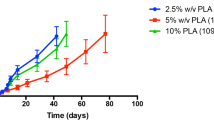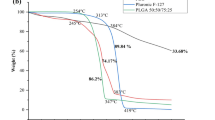Abstract
In this study, molecular dynamics simulations have been used to investigate the behavior of the drug rivastigmine and its carrier so-called poly (n-butyl cyanoacrylate) in the encapsulation process. Polymer modeling, and subsequently the emulsion polymerization model, were applied to analyze drug release in vitro and to justify rivastigmine transport across the blood–brain barrier (BBB) and polymer agglomeration. On the other hand, suitable polymer chain length, encapsulation method, polarity between polymer and drug structure, and finally, pattern of drug released in vitro and in vivo have been investigated to analyze the behavior of drug and polymer accurately. Maximum drug loading was determined based on the modeling of drug encapsulation and comparison of the radius of gyration of polymer (Rg) and distance between center of masses (COMs) of rivastigmine molecules and polymer in equilibrium condition (A°). With the aim of better understanding of drug release, we calculated the Flory–Huggins interaction parameter, diffusion coefficient, and intermolecular interaction energy. The results reveal that more drug molecules remain on the surface of the polymeric structure, with increasing the concentration of rivastigmine molecules from 3 up to 7, but the number of encapsulated drug molecules inside of the polymer remains constant. Also, calculated values of Gibbs free energy indicated that intramolecular interactions of the polymer chain overcome the intermolecular interactions between polymer and drug. Therefore, any extra loading of drug resulted in accumulation on the polymer surface.

Poly (n-butyl cyanoacrylate) containing rivastigmine molecules









Similar content being viewed by others
References
Dronse J, Fliessbach K, Bischof GN, von Reutern B, Faber J, Hammes J et al (2017) In vivo patterns of tau pathology, amyloid-β burden, and neuronal dysfunction in clinical variants of Alzheimer’s disease. J Alzheimers Dis 55:465
Burns A, lliffe S (2009) Alzheimer’s disease. BMJ 338:467
Dasgupta A, Liu M, Ojha T, Storm G, Kiessling F, Lammers T (2016) Ultrasound-mediated drug delivery to the brain: principles, progress and prospects. Drug Discov Today Technol 20:41
Barage SH, Sonawane KD (2015) Amyloid cascade hypothesis: pathogenesis and therapeutic strategies in Alzheimer’s disease. Neuropeptides 52:1
Craig LA, Hong NS, McDonald RJ (2011) Revisiting the cholinergic hypothesis in the development of Alzheimer’s disease. Neurosci Biobehav Rev 35:1397
Hardy J, Selkoe DJ (2002) The amyloid hypothesis of Alzheimer’s disease: progress and problems on the road to therapeutics. Science 297:353
Rosini M, Simoni E, Milelli A, Minarini A, Melchiorre C (2014) Oxidative stress in Alzheimer’s disease: are we connecting the dots? J Med Chem 57:2821
Lleó A, Greenberg SM, Growdon JH (2006) Current pharmacotherapy for Alzheimer’s disease. Annu Rev Med 57:513
Reitz C, Brayne C, Mayeux R (2011) Epidemiology of Alzheimer disease. Nat Rev Neurol 7:137
Jeřábek J, Uliassi E, Guidotti L, Korábečný J, Soukup O, Sepsova V et al (2017) Tacrine-resveratrol fused hybrids as multi-target-directed ligands against Alzheimer’s disease. Eur J Med Chem 127:250
Chen T-H, Chou M-C, Lai C-L, Wu S-J, Hsu C-L, Yang Y-H (2017) Factors affecting therapeutic response to rivastigmine in Alzheimer’s disease patients in Taiwan. Kaohsiung J Med Sci 33:277
Winblad B, Machado JC (2008) Use of rivastigmine transdermal patch in the treatment of Alzheimer’s disease. Expert Opin Drug Deliv 5:1377
Scialabba C, Rocco F, Licciardi M, Pitarresi G, Ceruti M, Giammona G (2012) Amphiphilic polyaspartamide copolymer-based micelles for rivastigmine delivery to neuronal cells. Drug Deliv 19:307
Bond M, Rogers G, Peters J, Anderson R, Hoyle M, Miners A et al (2012) The effectiveness and cost-effectiveness of donepezil, galantamine, rivastigmine and memantine for the treatment of Alzheimer’s disease (review of technology appraisal no. 111): a systematic review and economic model. Health Technol Assess 16:1
Ballard CG (2002) Advances in the treatment of Alzheimer’s disease: benefits of dual cholinesterase inhibition. Eur Neurol 47:64
Sahni JK, Doggui S, Ali J, Baboota S, Dao L, Ramassamy C (2011) Neurotherapeutic applications of nanoparticles in Alzheimer’s disease. J Control Release 152:208
Roney C, Kulkarni P, Arora V, Antich P, Bonte F, Wu A et al (2005) Targeted nanoparticles for drug delivery through the blood–brain barrier for Alzheimer’s disease. J Control Release 108:193
Doggui S, Dao L, Ramassamy C (2012) Potential of drug-loaded nanoparticles for Alzheimer’s disease: diagnosis, prevention and treatment. Ther Deliv 3:1025
Razmimanesh F, Amjad-Iranagh S, Modarress H (2015) Molecular dynamics simulation study of chitosan and gemcitabine as a drug delivery system. J Mol Model 21:165
Ramge P, Unger RE, Oltrogge JB, Zenker D, Begley D, Kreuter J et al (2000) Polysorbate-80 coating enhances uptake of polybutylcyanoacrylate (PBCA)-nanoparticles by human and bovine primary brain capillary endothelial cells. Eur J Neurosci 12:1931
Bagad M, Khan ZA (2015) Poly (n-butylcyanoacrylate) nanoparticles for oral delivery of quercetin: preparation, characterization, and pharmacokinetics and biodistribution studies in Wistar rats. Int J Nanomedicine 10:3921
Wilson B, Samanta MK, Santhi K, Kumar KPS, Paramakrishnan N, Suresh B (2008) Poly (n-butylcyanoacrylate) nanoparticles coated with polysorbate 80 for the targeted delivery of rivastigmine into the brain to treat Alzheimer’s disease. Brain Res 1200:159
Xu J, Ziegler KJ (2014) Coating hydrophobic biopolymers around single-walled carbon nanotubes for biomedical application. In: Meeting abstracts. MA2014-01:1171
Markova N, Ivanova G, Enchev V, Simeonova M (2012) Tacticity of poly (butyl-α-cyanoacrylate) chains in nanoparticles: NMR spectroscopy and DFT calculations. J Struct Chem 23:815
Eslami M, Nikkhah SJ, Hashemianzadeh SM, Sajadi SAS (2016) The compatibility of tacrine molecule with poly (n-butylcyanoacrylate) and chitosan as efficient carriers for drug delivery: a molecular dynamics study. Eur J Pharm Sci 82:79
Wang Y, Li X, Wei Q, Yang M, Wei S (2015) Study on the mechanical properties of three-dimensional directly binding hydroxyapatite powder. Cell Biochem Biophys 72:289
Wang Y, Wei Q, Pan F, Yang M, Wei S (2014) Molecular dynamics simulations for the examination of mechanical properties of hydroxyapatite/poly α-n-butyl cyanoacrylate under additive manufacturing. Biomed Mater Eng 24:825
Donnelly E, Johnston D, Pepper D, Dunn D (1977) Ionic and zwitterionic polymerization of n-alkyl 2-cyanoacrylates. Polym Lett Ed 15:399
Plimpton S (1995) Fast parallel algorithms for short-range molecular dynamics. J Comput Phys 117:1
Heinz H, Koerner H, Anderson KL, Vaia RA, Farmer B (2005) Force field for mica-type silicates and dynamics of octadecylammonium chains grafted to montmorillonite. Chem Mater 17:5658
Sun H (1998) COMPASS: an ab initio force-field optimized for condensed-phase applications overview with details on alkane and benzene compounds. J Phys Chem B 102:7338
Moon J, Yang S, Cho M (2017) Interfacial strengthening between graphene and polymer through stone-thrower-Wales defects: ab initio and molecular dynamics simulations. Carbon 118:66
Parks ML, Seleson P, Plimpton SJ, Silling SA, Lehoucq RB (2008) Peridynamics with LAMMPS: a user guide. Technical Report SAND 2008-1035. Sandia National Laboratories, Livermore
Barton AFM (1990) Handbook of polymer-liquid interaction parameters and solubility parameters. CRC, Boca Raton
Alavianmehr M, Hosseini S, Mohsenipour A, Moghadasi J (2016) Further property of ionic liquids: Hildebrand solubility parameter from new molecular thermodynamic model. J Mol Liq 218:332
Xu W-S, Douglas JF, Freed KF (2016) Influence of cohesive energy on the thermodynamic properties of a model glass-forming polymer melt. Macromolecules 49:8341
Martínez L, Andrade R, Birgin EG, Martínez JM (2009) PACKMOL: a package for building initial configurations for molecular dynamics simulations. J Comput Chem 30:2157
Garcia-Garcia D, Fenollar O, Fombuena V, Lopez-Martinez J, Balart R (2016) Improvement of mechanical ductile properties of poly(3-hydroxybutyrate) by usingvegetable oil derivatives. Macromol Mater Eng. https://doi.org/10.1002/mame.201600330
Small PA (1953) Some factors affecting the solubility of polymers. J Appl Chem 3:71
Jawalkar SS, Raju KV, Halligudi SB, Sairam M, Aminabhavi TM (2007) Molecular modeling simulations to predict compatibility of poly (vinyl alcohol) and chitosan blends: a comparison with experiments. J Phys Chem B 111:2431
Jin X, Asghar S, Zhu X, Chen Z, Liu J, Li Y et al (2017) Enhanced oral bioavailability of 10-hydroxycamptothecin through the use of poly (n-butyl cyanoacrylate) nanospheres. Drug Dev Ind Pharm 43:1
Kollman P (1993) Free energy calculations: applications to chemical and biochemical phenomena. Chem Rev 93:2395
Mezei M (1987) The finite difference thermodynamic integration, tested on calculating the hydration free energy difference between acetone and dimethylamine in water. J Chem Phys 86:7084
Bennett CH (1976) Efficient estimation of free energy differences from Monte Carlo data. J Comput Phys 22:245
Andrew RL (2001) Molecular modeling principles and applications. Addison Wesley Longman, Essex
Weeks JD, Chandler D, Andersen HC (1971) Role of repulsive forces in determining the equilibrium structure of simple liquids. J Chem Phys 54:5237
Gapsys V, Seeliger D, de Groot BL (2012) New soft-core potential function for molecular dynamics based alchemical free energy calculations. J Chem Theory Comput 8:2373
Beutler TC, Mark AE, van Schaik RC, Gerber PR, van Gunsteren WF (1994) Avoiding singularities and numerical instabilities in free energy calculations based on molecular simulations. Chem Phys Lett 222:529
Einstein A (1905) On the motion of small particles suspended in liquids at rest required by the molecular-kinetic theory of heat. Ann Phys 17:549
Fixman M (1962) Radius of gyration of polymer chains. J Chem Phys 36:306
Yaghini N, Iedema PD (2015) Branching determination from radius of gyration contraction factor in radical polymerization. Polymer 59:166
Chen Y, Liu C, Chen Z, Su C, Hageman M, Hussain M et al (2015) Drug–polymer–water interaction and its implication for the dissolution performance of amorphous solid dispersions. Mol Pharm 12:576
Patel S, Lavasanifar A, Choi P (2008) Application of molecular dynamics simulation to predict the compatability between water-insoluble drugs and self-associating poly (ethylene oxide)-b-poly (ε-caprolactone) block copolymers. Biomacromolecules 9:3014
Tian Y, Booth J, Meehan E, Jones DS, Li S, Andrews GP (2012) Construction of drug–polymer thermodynamic phase diagrams using Flory–Huggins interaction theory: identifying the relevance of temperature and drug weight fraction to phase separation within solid dispersions. Mol Pharm 10:236
Langhoff E, Ladefoged J (1985) Sodium activity, sodium concentration, and osmolality in plasma in acute and chronic renal failure. Clin Chem 31:1811
Ghosh S, Patel N, Chakrabarti R (2016) Probing the salt concentration dependent nucleobase distribution in a single-stranded DNA–single-walled carbon nanotube hybrid with molecular dynamics. J Phys Chem B 120:455
Rungnim C, Rungrotmongkol T, Hannongbua S, Okumura H (2013) Replica exchange molecular dynamics simulation of chitosan for drug delivery system based on carbon nanotube. J Mol Graph Model 39:183
Arsawang U, Saengsawang O, Rungrotmongkol T, Sornmee P, Wittayanarakul K, Remsungnen T et al (2011) How do carbon nanotubes serve as carriers for gemcitabine transport in a drug delivery system? J Mol Graph Model 29:591
Calvaresi M, Hoefinger S, Zerbetto F (2012) Probing the structure of lysozyme–carbon-nanotube hybrids with molecular dynamics. Chem Eur J 18:4308
D’Amelia RP, Tomic JC, Nirode WF (2014) The determination of the solubility parameter (δ) and the Mark-Houwink constants (K & α) of food grade polyvinyl acetate (PVAc). J Polym Biopolym Phys Chem 2:67
Colombo I, Grassi M, Lapasin R, Pricl S (1997) Determination of the drug diffusion coefficient in swollen hydrogel polymeric matrices by means of the inverse sectioning method. J Control Release 47:305
Acknowledgments
We are grateful to Dr. Amin Khorsandi, Dr. Foad Mehri, and Dr. Mostafa Rahimian for scientific discussions and their friendly support.
Author information
Authors and Affiliations
Corresponding author
Electronic supplementary material
ESM 1
(DOCX 21 kb)
Rights and permissions
About this article
Cite this article
Mousavi, S.V., Hashemianzadeh, S.M. Poly (n-butyl cyanoacrylate) as a nanocarrier for rivastigmine transport across the blood–brain barrier in Alzheimer’s disease treatment: a perspective from molecular dynamics simulations. J Mol Model 24, 252 (2018). https://doi.org/10.1007/s00894-018-3799-0
Received:
Accepted:
Published:
DOI: https://doi.org/10.1007/s00894-018-3799-0




